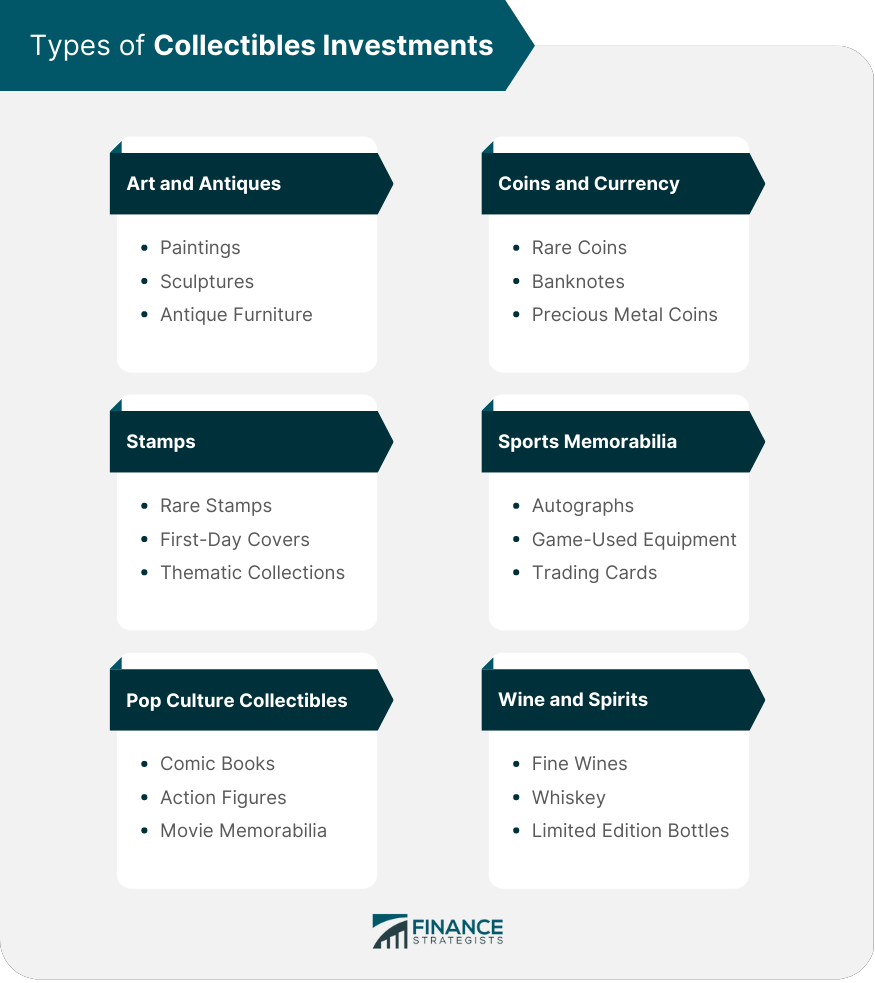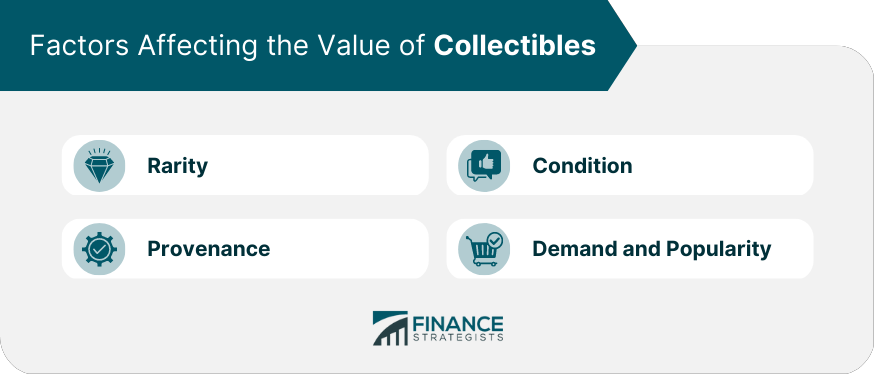Collectibles investments refer to the practice of purchasing and holding items of value, such as art, antiques, coins, stamps, sports memorabilia, and other unique objects, with the expectation of generating a financial return over time. These alternative investments offer the potential for significant appreciation in value while also providing collectors with personal enjoyment and a sense of accomplishment. Investors may choose to invest in collectibles for various reasons, including the potential for high returns, diversification of their investment portfolios, a hedge against inflation, and personal passion for a particular category of collectibles. There are numerous categories of collectibles, with some of the most popular being art and antiques, coins and currency, stamps, sports memorabilia, pop culture collectibles, and wine and spirits. Over the long term, many collectibles have demonstrated strong appreciation in value, outperforming traditional investments such as stocks and bonds in certain periods. However, the performance of individual collectibles can vary significantly based on factors such as rarity, condition, provenance, and market demand. While some collectibles have produced impressive returns, they generally exhibit higher risk and volatility levels than traditional investments. Additionally, collectibles are often illiquid, meaning they can be more difficult to sell quickly and at a fair market price. The value of collectibles can be influenced by various economic, social, and cultural factors, resulting in market trends and cycles. Investors should be aware of these dynamics and be prepared to navigate changing market conditions. Investing in paintings can range from acquiring works by established masters to discovering emerging talents. The value of a painting is influenced by factors such as the artist's reputation, the work's historical significance, and its aesthetic appeal. Sculptures are another popular category of art investment, with collectors often seeking pieces from renowned artists, unique materials, or striking designs. Antique furniture investments can include pieces from various historical periods and styles, with value often derived from craftsmanship, rarity, and condition. Rare coins can offer collectors significant investment potential, with value typically determined by factors such as rarity, condition, and historical significance. An example of a rare coin with significant investment potential is the 1933 Double Eagle, which has a face value of $20 but sold at an auction for over $7.59 million in 2002. Collecting rare or historically important banknotes can also provide investment opportunities, with value often driven by factors similar to those affecting rare coins. Investing in coins made of precious metals, such as gold or silver, can offer both numismatic value and intrinsic value derived from the underlying metal content. Collectors can highly seek rare stamps, with value influenced by factors such as rarity, condition, and historical significance. First-day covers, which are envelopes bearing stamps postmarked on their first day of issue, can also be collectible and offer potential investment value. Collecting stamps based on a particular theme, such as animals, famous personalities, or historical events, can provide an enjoyable and potentially profitable investment strategy. Autographs from famous athletes can command significant value, with factors such as rarity, authenticity, and the athlete's career achievements influencing the price. Game-used equipment, such as jerseys, gloves, or balls, can also offer investment potential, with value often derived from the item's provenance and connection to memorable moments in sports history. Sports trading cards have experienced a resurgence in popularity, with rare and high-grade cards from iconic athletes fetching substantial prices at auction. Investing in comic books can be lucrative, with key issues featuring the first appearances of iconic characters or important storylines often commanding high prices. Collectible action figures, particularly those in mint condition or with original packaging, can appreciate significantly in value over time. Movie memorabilia, such as props, costumes, and posters, can offer investment potential, with value often driven by the popularity and cultural significance of the film. Investing in fine wines can provide both enjoyment and potential financial returns, with value influenced by factors such as rarity, vintage, and critical acclaim. Collecting whiskey, particularly rare or limited-edition bottles, has become an increasingly popular investment strategy, with some bottles appreciating significantly in value over time. Limited-edition bottles of wine, spirits, or other beverages can offer collectors investment potential, with value often driven by rarity, packaging design, and brand prestige. Rarity is a key factor in determining the value of a collectible, with rarer items often commanding higher prices due to limited supply and increased demand. The condition of a collectible can greatly impact its value, with items in better condition typically fetching higher prices than those with signs of wear or damage. Provenance, or the documented history of an item's ownership and origin, can significantly influence a collectible's value. Items with a well-documented and reputable provenance are generally more valuable and desirable to collectors. The demand for and popularity of a particular collectible can significantly determine its value. Items associated with popular culture or those that resonate with a large audience tend to appreciate more rapidly in value. Collectibles markets can be volatile, with values fluctuating based on factors such as economic conditions, cultural trends, and collector preferences. Collectibles are often illiquid investments, meaning they can be difficult to sell quickly and at a fair market price. Counterfeits and forgeries are significant risks in the collectibles market, as unscrupulous individuals may attempt to profit by selling fraudulent items to unsuspecting buyers. Owning collectibles can entail storage, maintenance, and insurance costs, which should be factored into an investor's overall investment strategy. Investing solely in collectibles can limit an investor's portfolio diversification, potentially exposing them to higher levels of risk. Investors should thoroughly research and educate themselves about the collectibles market, including the specific categories they are interested in, to make informed investment decisions. Creating a diversified portfolio of collectibles across various categories can help investors manage risk and potentially benefit from different market trends. Developing relationships with experts and other collectors can provide valuable insights, advice, and access to unique buying opportunities. Successful collectibles investing often requires patience, a long-term perspective, and an understanding of market timing to capitalize on buying or selling opportunities. When sold at a profit, collectibles investments may be subject to capital gains tax. Investors should be aware of the tax implications of their investments and consult with a tax professional for guidance. Estate tax and inheritance taxes may apply to collectibles as part of an individual's estate. Proper estate planning can help minimize tax liabilities and ensure a smooth transfer of assets to heirs. Collectibles should be properly insured to protect against potential loss or damage. Regular appraisals can help ensure that insurance coverage remains adequate and reflects current market values. Importing and exporting collectibles may be subject to various regulations and restrictions, depending on the type of collectible and the countries involved. Investors should familiarize themselves with these regulations to avoid potential legal complications. Collectibles investments refer to the practice of purchasing and holding items of value with the expectation of generating a financial return over time. Given the complexities and nuances of the collectibles market, partnering with a wealth management expert can be invaluable in making well-informed decisions and maximizing investment potential. What Are Collectibles Investments?
Historical Performance of Collectibles Investments
Long-Term Returns
Comparison With Traditional Investments
Market Trends and Cycles
Types of Collectibles Investments
Art and Antiques
Paintings
Sculptures
Antique Furniture
Coins and Currency
Rare Coins
Banknotes
Precious Metal Coins
Stamps
Rare Stamps
First-Day Covers
Thematic Collections
Sports Memorabilia
Autographs
Game-Used Equipment
Trading Cards
Pop Culture Collectibles
Comic Books
Action Figures
Movie Memorabilia
Wine and Spirits
Fine Wines
Whiskey
Limited-Edition Bottles

Factors Affecting the Value of Collectibles
Rarity
Condition
Provenance
Demand and Popularity

Risks Associated With Collectibles Investments
Market Volatility
Illiquidity
Counterfeits and Forgeries
Storage and Maintenance Costs
Limited Diversification
Strategies for Investing in Collectibles
Research and Education
Building a Diversified Portfolio
Networking With Experts and Collectors
Timing and Patience
Tax and Legal Considerations of Collectibles Investments
Capital Gains Tax
Estate and Inheritance Tax
Insurance and Appraisals
Import and Export Regulations
Conclusion
Collectibles investments can be divided into various categories, including art and antiques, coins and currency, stamps, sports memorabilia, pop culture collectibles, and wine and spirits.
Investing in collectibles generally exhibits higher risk and volatility levels than traditional investments, and collectibles are often illiquid, meaning they can be more difficult to sell quickly and at a fair market price.
Successful collectibles investing often requires patience, a long-term perspective, and an understanding of market timing to capitalize on buying or selling opportunities.
Investors should also be aware of various factors that can impact the value of collectibles, including rarity, condition, provenance, demand, and popularity.
Collectibles Investments FAQs
Collectibles investments offer several benefits, including the potential for high returns, portfolio diversification, a hedge against inflation, and personal enjoyment for those passionate about specific categories of collectibles. These investments can provide an alternative avenue for growing wealth and enhancing investment strategies.
Collectibles investments may not be suitable for everyone. They generally involve higher risks, greater price volatility, and illiquidity compared to traditional investments like stocks and bonds. Investors considering collectibles investments should thoroughly understand the market and be willing to take on the associated risks. Consulting a wealth management expert can help determine if collectibles investments are appropriate for your specific financial goals and risk tolerance.
The value of collectibles investments is influenced by factors such as rarity, condition, provenance, and market demand. To determine the value of a collectible, you can consult with experts, review recent auction results, and research market trends. Regular appraisals by a professional can also help ensure that your collectibles are accurately valued and properly insured.
To minimize risks associated with collectibles investments, consider building a diversified portfolio across various categories, conducting thorough research, networking with experts and fellow collectors, and staying informed about market trends and emerging opportunities. Additionally, partnering with a wealth management expert can help you navigate the complexities of the collectibles market and make well-informed decisions.
Collectibles investments may be subject to capital gains tax when sold at a profit and may also be subject to estate and inheritance taxes as part of an individual's estate. Proper insurance and appraisals are important to protect your investment. Importing and exporting collectibles may be subject to regulations and restrictions, depending on the type of collectible and the countries involved. It is important to consult with tax and legal professionals to ensure compliance and to minimize potential liabilities related to your collectibles investments.
True Tamplin is a published author, public speaker, CEO of UpDigital, and founder of Finance Strategists.
True is a Certified Educator in Personal Finance (CEPF®), author of The Handy Financial Ratios Guide, a member of the Society for Advancing Business Editing and Writing, contributes to his financial education site, Finance Strategists, and has spoken to various financial communities such as the CFA Institute, as well as university students like his Alma mater, Biola University, where he received a bachelor of science in business and data analytics.
To learn more about True, visit his personal website or view his author profiles on Amazon, Nasdaq and Forbes.















